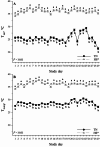Early gestation heat stress influences fetal biomarkers indicative of maternal cortisol transfer in pigs
- PMID: 40702145
- PMCID: PMC12287300
- DOI: 10.1038/s41598-025-12698-w
Early gestation heat stress influences fetal biomarkers indicative of maternal cortisol transfer in pigs
Abstract
In utero heat stress (IUHS) alters hypothalamic-pituitary-adrenal (HPA) axis development in pigs; however, the mechanisms mediating this effect remain unclear. This study aimed to evaluate cortisol transfer dynamics from the heat-stressed (HS) dam to the IUHS conceptus during early gestation. We hypothesized that gestational HS would modify maternal cortisol secretion and increase conceptus cortisol exposure. Twenty-three gilts were exposed to thermoneutral (TN; n = 11) or HS (n = 12) conditions from gestation d 6 to 33. Maternal vaginal temperature, respiration rate, skin temperatures, and salivary cortisol concentrations were monitored. On d 33, dams were harvested to assess fetal and reproductive tract morphology and collect fetal and placental samples for glucocorticoid and 11β-HSD2 analyses. Heat-stressed gilts exhibited increased (P ≤ 0.01) vaginal temperature, respiration rate, and skin temperatures, but salivary cortisol was similar (P = 0.13). Total and viable fetuses per corpus luteum were reduced (P ≤ 0.05) in HS dams. Fetal tissue cortisone: cortisol tended to be reduced (P = 0.06) and was reduced in IUHS fetus amniotic fluid (P = 0.03). Amniotic fluid cortisone tended to decrease (P = 0.07), while cortisol tended to increase (P = 0.08) in IUHS fetuses. These data suggest IUHS increases fetal glucocorticoid exposure.
Keywords: In utero heat stress; 11β-HSD2; Fetal cortisol; Fetal cortisone; Maternal cortisol.
© 2025. The Author(s).
Conflict of interest statement
Declarations. Competing interests: The authors declare no competing interests.
Figures





Similar articles
-
Effect of repeated HPA axis stimulation on hair cortisol concentration, growth, and behavior in preweaned dairy cattle.J Anim Sci. 2024 Jan 3;102:skae171. doi: 10.1093/jas/skae171. J Anim Sci. 2024. PMID: 38898575 Free PMC article.
-
NTP Developmental and Reproductive Toxicity Technical Report on the Prenatal Development Studies of 2-((1-(4-Phenoxyphenoxy)propan-2-yl)oxy)pyridine (CASRN 95737-68-1) in Sprague Dawley (Hsd:Sprague Dawley® SD®) Rats and New Zealand White (Hra:NZW SPF) Rabbits: DART Report 07 [Internet].Research Triangle Park (NC): National Toxicology Program; 2022 Jan. Research Triangle Park (NC): National Toxicology Program; 2022 Jan. PMID: 35593777 Free Books & Documents. Review.
-
Rate of body weight gain during early gestation in F0 beef heifers has effects that extend multigenerationally to the F2 fetuses.J Anim Sci. 2024 Jan 3;102:skae295. doi: 10.1093/jas/skae295. J Anim Sci. 2024. PMID: 39324625
-
Late gestation heat stress induces inflammation and impacts nutrient transfer signature in the placenta of dairy cows.Theriogenology. 2025 Oct 1;245:117506. doi: 10.1016/j.theriogenology.2025.117506. Epub 2025 May 27. Theriogenology. 2025. PMID: 40480157
-
Hypothalamic-pituitary-adrenal (HPA) axis suppression after treatment with glucocorticoid therapy for childhood acute lymphoblastic leukaemia.Cochrane Database Syst Rev. 2017 Nov 6;11(11):CD008727. doi: 10.1002/14651858.CD008727.pub4. Cochrane Database Syst Rev. 2017. PMID: 29106702 Free PMC article.
References
-
- Johnson, J. S., Stewart, K. R., Safranski, T. J., Ross, J. W. & Baumgard, L. H. In utero heat stress alters postnatal phenotypes in swine. Theriogenology. 154, 110–119. (2020). 10.1016/j.theriogenology.2020.05.013 - PubMed
-
- NOAA. National Centers for Environmental Information, State of the Climate: National Climate Report for Annual 2025. Retrieved April 11. (2025). Available at: https://www.ncei.noaa.gov/access/monitoring/monthly-report/global/202501...
MeSH terms
Substances
LinkOut - more resources
Full Text Sources

